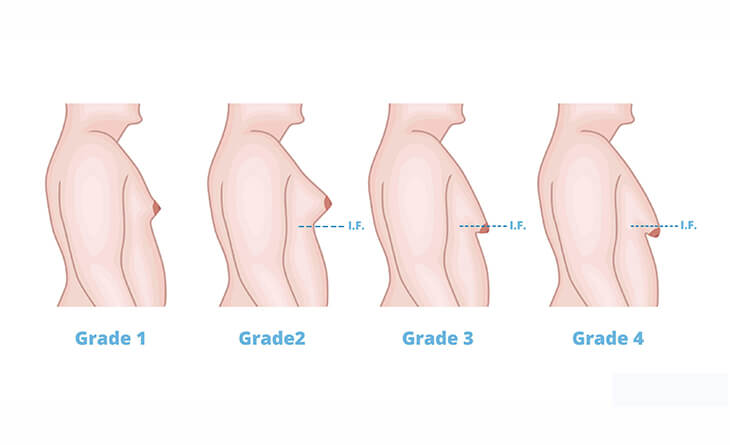Gynecomastia (sometimes referred as man boobs) is a relatively common condition where a boy’s or man’s breast is larger than normal. The spectrum of the condition could extend from just a small amount of extra tissue around the nipple to more prominent female-like breasts. Gynecomastia results from an imbalance in the hormonal environment in the body, usually around puberty, with a relative excess of estrogens as compared to androgens. As a result, the breast tissue under the nipple starts to grow and this is accompanied by deposition of fat around it. The effect of this estrogen excess can happen in a newborn baby, teenage boys around puberty or even older men in their 40s and 50s.
Genetic factors, old age, obesity, some commonly used medications, anabolic steroids, chronic alcohol abuse, drug addiction and certain diseases like chronic liver failure are some of the other causes of gynecomastia. In most cases of peri-pubertal gynecomastia, observation and reassurance are the main stay of treatment. Pharmacological treatment and surgery are recommended in carefully selected cases.

Am I the Right Candidate?
Although the incidence of patients visiting doctors with gynaecomastia appears to be on the rise, surgery is not indicated in all cases, since the minor variety of the condition is extremely common. Living with gynaecomastia does not affect any other aspect of a person’s life, except for the cosmetic appearance that most people are uncomfortable or embarrassed about. The classical complaint is that it causes social stigma, not allowing one to wear a fitting t-shirt or to take off one’s shirt in public. In the younger patient, especially those in their teens, this may result in severe psychological issues because of being teased or tormented by peers. In such cases, when it is a cause of great mental discomfort, you need to consult a qualified plastic / cosmetic surgeon.
Treating gynecomastia
When you visit a plastic surgeon, the diagnosis is quickly apparent on physical examination. In most cases of pubertal gynaecomastia, which is the commonest, the history and physical examination is adequate for a complete diagnosis. In certain cases, after examining other areas of the body, such as the external genitalia, the surgeon may ask for some specialized blood tests, to confirm the cause.
The condition can be treated permanently only by surgery, under local anaesthesia with sedation or general anaesthesia. This may be by liposuction or open reduction or most commonly a combination of both. This depends on whether the condition is predominantly fatty, predominantly glandular or a combination of both. Liposuction is always performed as part of the surgical treatment to remove the excess breast fat and shred the gland tissue. If the gland tissue is significant or it is too firm / hard, then it needs to be removed by open excision. Failing to do this completely can make the condition recur. The excess loose skin after the surgery is usually allowed to shrink as much as possible using compression garment support. At the end of 3 months, if there is still some residual loose skin, it may either be ignored or if the patient wishes, only the excess skin can be tightened by another procedure. Rarely in the most severe cases where the growth is like a female breast, the surgery may need to be similar to that done for a breast reduction in females with more visible scars.

What kind of results can be expected?
The benefits of gynecomastia surgery are that when properly done, the result is permanent. This is why it is important that the procedure be done by a qualified plastic/cosmetic surgeon. It will restore a naturally masculine appearance to your chest. With a firmer, flatter, and better-shaped chest, the patient feels more confident with vastly increased self-esteem.
What can go wrong and how it is remedied?
Gynecomastia surgery is typically a short procedure with a quick recovery and virtually invisible scars. The two main side effects after gynecomastia surgery are post-operative pain and the presence of scars on the chest.
Significant pain is usually felt for only 24-48 hours and can be taken care of well with pain-killers. An attempt is always made to limit scars, place them in natural folds or around the periphery of the areola or directly through the nipple. By 3-6 months after surgery, the scars are practically invisible in most cases.
Sometimes contour irregularities may be visible after the swelling subsides. Rarely wound infection, seroma (collection of fluid under the skin), hematoma may occur. Your surgeon will give you antibiotics for some days to avoid infection. Small irregularities can be taken care of secondarily after a few months under local anaesthesia. Most patients experience a reduction or loss of sensation in the treated areas but this is almost always temporary.
Common Do’s and Don’ts after the surgery
You may be allowed to go home the same day or at the most need to stay overnight in the hospital depending on the amount of fat and breast gland removed. Your chest area may be bruised and swollen for a couple of weeks, but this will gradually reduce. You will be required to wear a supporting compression garment 24/7 for up to six weeks after surgery to support and compress your chest.
Most patients can return to work within 5-7 days after their gynecomastia surgery. You will be instructed to avoid any heavy lifting or strenuous activity for up to six weeks after surgery and not drive until you feel comfortable wearing a seatbelt. Male breast reduction results are meant to be permanent – the excess fat, glandular tissue and skin, once removed are gone for good. However, it’s important to maintain a healthy lifestyle. Significant weight gain, steroid abuse, or certain medical conditions which cause hormonal imbalances could result in a recurrence of fatty gynecomastia.
